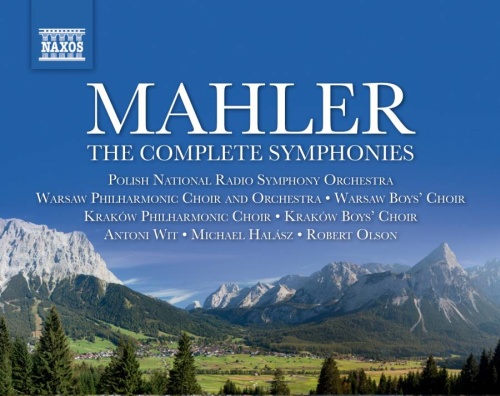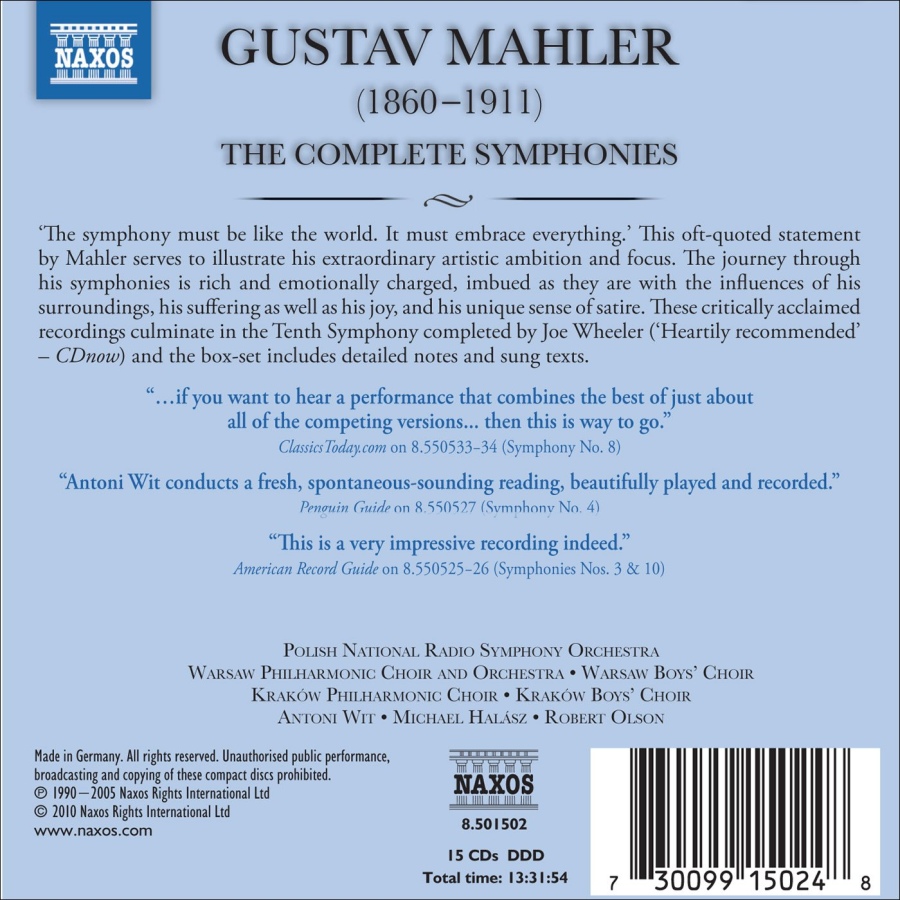
kompozytor
Mahler, Gustav
tytuł
Mahler: Complete Symphonies (15 CD)
wykonawcy
Polish National Radio Symphony Orchestra (NOSPR Katowice);
Wit, Antoni;
Halász, Michael
Wit, Antoni;
Halász, Michael
nr katalogowy
8.501502
opis
The Polish National Symphony...sounds thoroughly comfortable with his unique idiom. Yet when I say correct Mahler style, I must amend that because there is no one Mahler style. His symphonies are unique in being able to withstand several different approaches, from fairly swift, taut, and dramatic to slow, alternately relaxed or tense, and brooding. Moreover, I m pretty sure Mahler himself changed the way he conducted his own symphonies from year to year, depending on his mood at the time. This particular set, primarily the work of two Polish conductors, is fascinating in that it gives us Mahler not in a German or Anglo-Saxon vernacular, which is how most of us came to know it (even through Klemperer, Walter, Barbolli, and Horenstein), but rather through an Eastern European vernacular. Leonard Bernstein often said that one can grasp the correct rhythmic feel of a classical work by learning something of the speech patterns of the composer s homeland, and he was right. Except for the 10th Symphony, led here by American Robert Olson, this is Mahler with a Polish-Bohemian accent, and as such is probably closer to what the composer himself heard in his mind when writing it...Not only Halász but also Wit is sometimes forced to decide between reaching for that one finely etched detail that makes or breaks a phrase or going for the big picture. What s amazing is that so much of it does come off well that I found myself having fewer complaints about any single performance in this set than about others performances. The sound quality is, to my ears, simply spectacular and exactly what I want to hear in Mahler: crystal-clear reproduction of the instruments but enough ambience and right-left separation to give that exciting 3-D quality to Mahler that his music demands...these conductors particularly Wit know so well what to do with the rest of the music...In that first movement of the Third, for instance, Wit is the only conductor I ve heard besides Michael Tilson Thomas (in his earlier recording with the London Symphony) who makes musical sense of that first movement, tying the strands together to make it sound coherent and not episodic...Wit brings a similar sense of continuity and beautiful chamber-like atmosphere to the often fragmented Symphony of a Thousand. Olson s 10th, in the rare edition by Joe Wheeler, was not as emotional an experience as Mark Wigglesworth s superb Deryck Cooke 10th, but it s still better than anyone else s. I ve heard so many really disappointing performances in the supposedly top-drawer cycles of Georg Solti, Benjamin Zander, James Levine, Bernstein, Leif Segerstam, Christoph von Dohnányi, Tilson Thomas, Klaus Tennstedt, etc., that finding a slightly weak or ineffective moment here and there doesn t really dull my enthusiasm for this set as a whole. Would I recommend any performances as a first choice? Yes, three: Symphonies Nos. 3, 7, and 8. But many of the others were, for me, clearly second choices (Nos. 2, 4, 5, 6, 9, and 10), and since several of my first choices are rare and/or out-of-print recordings (such as the Mehta Second, Tennstedt Fifth, and Kubelík Seventh on the out-of-print New York Philharmonic boxed set), as a whole it is certainly first choice as a complete cycle. I was also quite happy that the booklet includes all the lyrics of all the sung symphonies. Even at Naxos s list price, it s cheaper than any of the cycles I cited in the above paragraph, and shopping online will find you a discounted price that s more than easy to live with. --Fanfare
• Mahler: Symphony No. 1 in D major 'Titan':
• Mahler: Symphony No. 2 'Resurrection':
• Mahler: Symphony No. 3:
• Mahler: Symphony No. 4:
• Mahler: Symphony No. 5:
• Mahler: Symphony No. 6 in A minor 'Tragic':
• Mahler: Symphony No. 7:
• Mahler: Symphony No. 8 in E flat major 'Symphony of a Thousand':
• Mahler: Symphony No. 9:
• Mahler: Symphony No. 10 in F sharp major
Works:
• Mahler: Symphonies 1-9:
• Mahler: Symphony No. 1 in D major 'Titan':
• Mahler: Symphony No. 2 'Resurrection':
• Mahler: Symphony No. 3:
• Mahler: Symphony No. 4:
• Mahler: Symphony No. 5:
• Mahler: Symphony No. 6 in A minor 'Tragic':
• Mahler: Symphony No. 7:
• Mahler: Symphony No. 8 in E flat major 'Symphony of a Thousand':
• Mahler: Symphony No. 9:
• Mahler: Symphony No. 10 in F sharp major
nośnik
CD
x 15
gatunek
Muzyka klasyczna
producent
Naxos
data wydania
06-05-2010
EAN / kod kreskowy
730099150248

(Produkt nie został jeszcze oceniony)
cena 219,00 zł
lubProdukt na zamówienie
Wysyłka ustalana indywidualnie.
Darmowa wysyłka dla zamówień powyżej 300 zł!
Darmowy kurier dla zamówień powyżej 500 zł!
sprawdź koszty wysyłki












































